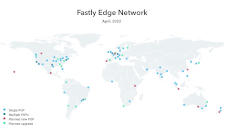Edge Server
An edge server is a computer located at the "edge" of the Internet, serving users in a specific area. CDNs and edge computing services use edge servers to provide Internet content and computing power as fast as possible.
Edge servers are distributed around the world at locations called points of presence, or PoPs. By placing servers closer to users, latency is reduced, and Internet users can access data more quickly. For example, if someone in Tokyo accesses a website hosted in New York, the ping may be over half a second, causing a delay before the webpage loads. If the content is hosted on an edge server in Tokyo, the ping may be only a few milliseconds, allowing the webpage to load much faster.
CDN Edge Servers
Content delivery networks, or CDNs, use edge servers to cache content, such as websites and streaming media. They retrieve data from an origin server, then replicate it globally across the edge network. When a user in Brasil accesses a website with an origin server in England, the CDN may serve the content from an edge server in Rio de Janeiro.
Edge Computing Servers
Edge computing networks use edge servers to perform calculations in different locations worldwide. Handing computation tasks closer to the source of each request reduces roundtrip delays and provides faster response times. Examples include online ad targeting, video conferencing, and multiplayer gaming.
While edge servers provide users faster access to Internet content, they also have a secondary benefit — reducing Internet traffic. Since edge servers deliver content and computing power from locations close to each user, they decrease the data travel and total bandwidth required for each request.
 Test Your Knowledge
Test Your Knowledge